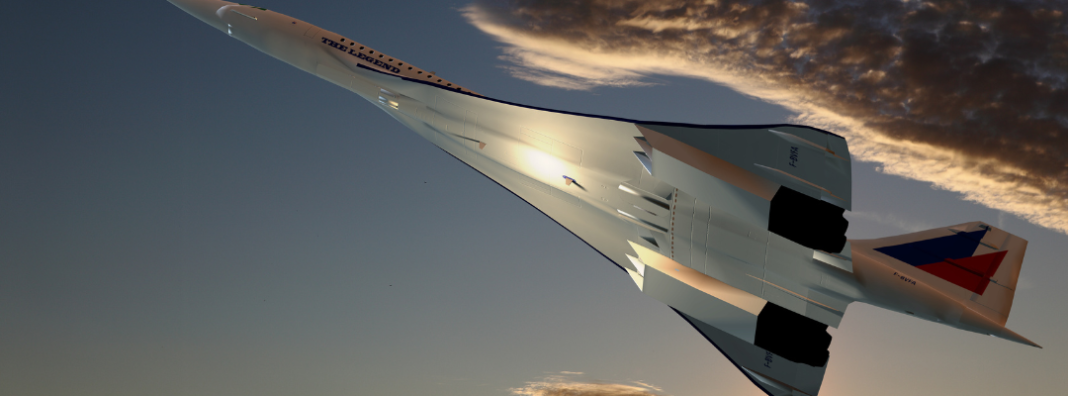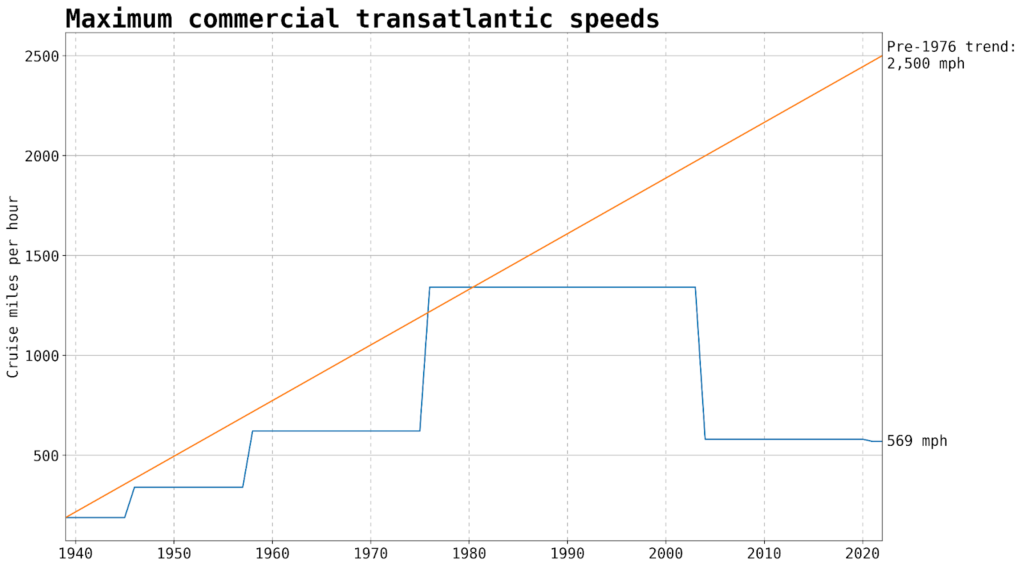
In 2016, Sam Hammond and I published a white paper called “Make America Boom Again,” calling for the return of supersonic flight. Our primary recommendation was that the Federal Aviation Administration should rescind the ban on overland supersonic aviation, which has been in place since 1973, and replace it with a sonic boom noise standard.
Over the time the overland ban has been in place, commercial airline speeds have stagnated and even regressed. Before the ban, speeds kept increasing. From the Boeing 314 Clipper to Concorde was only 37 years. Now that Concorde has retired, we are flying slower than the cruise speed of the Boeing 707 in 1958.
Had the ban never been instituted, it’s quite possible that we’d be cruising around the world today at 2,500 mph, nearly Mach 4. A flight between New York and Los Angeles would take a bit over an hour, like a flight between DC and Atlanta today.
The “MABA” paper made a decent splash when it came out and even circulated within the Department of Transportation. But six and half years later, the ban is still in place. The supersonic industry remains small, and a ticket on a supersonic airliner cannot be purchased at any price.
The core argument of MABA was that a prohibition on overland supersonic flight is a poor way to deal with the problem of sonic boom. The FAA should set a noise standard instead of a speed limit. The effect of the blanket overland ban was sadly predictable: It made it impossible for supersonic aviation to emerge at its natural entry point, business jets—smothering supersonic technology in its cradle.
Business jets log around 75 percent of their flight miles over land, which limits the attractiveness of supersonic technology for these planes as long as the ban is in place. Manufacturers attempting to work around the ban today must skip over the business jet segment and build a transoceanic airliner to target a Concorde-like market.
There are in principle more than enough routes that are primarily over water to justify a specific type of airliner for those flights, provided the performance of the plane is good enough. The market for premium-class transoceanic travel has more than doubled since Concorde retired in 2003. Fundamental technologies like carbon fiber and turbine engines have improved since Concorde was designed in the 1960s.
But even though a market for supersonic aircraft exists in spite of the overland ban, it is a hard one for a new entrant to serve. Aircraft program complexity doesn’t just increase with aircraft size, it increases superlinearly. The added development cost of an airliner versus a business jet means that a bigger market size is needed to justify the program. An airliner program is also harder to execute on. It would be much simpler for new supersonic airframers to start with business jets and expand into airliners over time.
Now more than ever, we need to repeal the overland ban and replace it with a sensible noise standard. However, contrary to what Sam and I wrote in MABA, I now think Congress and not the FAA should be the one to get the ball rolling.
The overland ban is contrary to statute
Authority for the FAA to control aircraft noise and sonic boom is given in 49 USC § 44715. The very first sentence says that the FAA Administrator shall, as he deems necessary, prescribe regulations to “control and abate” sonic boom.
However, in exercising this authority, 44715(b) requires the Administrator to undertake certain considerations, which are substantially unchanged from 1968, when Congress first gave FAA authority to address noise and sonic boom. The most important of these considerations is “whether the standard or regulation is consistent with the highest degree of safety.”
This makes sense. Aircraft noise and sonic boom are environmental matters, and while they are important, we do not want aircraft designers to make tradeoffs that compromise safety to achieve modest environmental benefits.
As a result, environmental standards in aviation are backwards-looking by design. Both the FAA and the International Civil Aviation Organization (ICAO), the United Nations aviation agency, generally revise environmental standards by plotting the environmental performance of late-model aircraft and ratcheting the standard down to the level these recent aircraft have attained.
The FAA is also required to consider “whether the standard or regulation is economically reasonable, technologically practicable, and appropriate for the applicable aircraft.” When noise standards are too stringent, they make certain kinds of aircraft impossible, either because the standard cannot be met with current technology or because meeting the standard harms aircraft performance so much that the aircraft is no longer economically viable.
In other words, Congress recognized the possibility that regulations could stymie innovation and tried to stop that from happening.
The normal way of addressing this concern is to follow the FAA’s and ICAO’s standard operating procedure. Again, these agencies typically look at the environmental performance of late-model aircraft and set standards based on the levels actually attained. Aircraft operating in the market are good indicators of what is economically reasonable and technologically practicable.
In its 1970 proposed rule to ban supersonic flight, however, the FAA did not use a backward-looking approach. Instead, it unceremoniously declared that overland supersonic flight was unnecessary for the further development of the industry: “Sonic boom producing flights over populated areas within the United States are believed to be economically and technologically ‘unnecessary’ as that word is used in section 611 [the precursor of the modern § 44715] of the Federal Aviation Act of 1958.”
It based this assessment on the following: “Traffic demand studies have concluded that from 500 to 800 supersonic transport airplanes will be in operation by the year 1990. Available studies conclude that these expected traffic demands are sufficient to insure an economically viable supersonic transport, even assuming a sonic boom restriction of the kind proposed in this notice.”
In other words, the FAA was arguing that a complete ban on civil supersonic flight was “economically reasonable, technologically practicable, and appropriate for the particular type of aircraft.” This was on the grounds that hundreds of supersonic transport airplanes would enter the market anyway in the following 20 years.
In reality, this prediction was way off the mark. Only 14 Concordes ever saw commercial passenger service. The Tupolev Tu-144, the Soviet “Concordski,” carried passengers on only 55 flights. To reiterate, today there is not a single commercial supersonic airliner in existence.
It’s clear in hindsight that the FAA’s prohibition on supersonic flight in the US was not economically reasonable or, for that matter, “appropriate” for supersonic aircraft. For the last 50 years, the ban has caused supersonic technology to stagnate. This was not Congress’s intention in giving the FAA the power to control and abate sonic boom.
The FAA has been cooperative recently, but problems remain
Although the overland ban was implemented in 1973, the FAA appeared actively hostile to supersonics through at least 2008, when it issued a policy statement saying that any future supersonic aircraft would have to abide by the takeoff and landing noise rules for subsonic aircraft. After all, the FAA argued, this stage of flight was subsonic, so why should the noise standards differ?
The retort, obvious to any aerospace engineer, is that supersonics have lower engine bypass ratios and higher fineness ratios than subsonic aircraft to reduce drag during cruise. These characteristics make subsonic noise performance at takeoff much more challenging. Subsonic standards cannot be applied while adhering to the economic reasonableness and appropriateness considerations required in § 44715.
More recently, however, the FAA has been more open to supersonic innovation. The 2008 policy has been superseded, first by a 2018 internal legal memo stating that subsonic noise standards did not apply to supersonics, and second by Congress’s codification (in § 181(f) of the 2018 FAA reauthorization) of internal policy that the FAA would make a suitable rule of particular applicability for any new supersonic applicant. The FAA has also been the global leader in pushing for reasonable and appropriate supersonic standards at ICAO.
In spite of this more recent support for supersonics, the FAA is in a challenging position regarding the overland ban. For one, any agency-led repeal of the overland ban will require a full NEPA review. The environmental impact statement would be highly contentious and lead to litigation. Knowing this, the FAA would likely take many years to complete the EIS, in an effort to make it bulletproof. Even so, litigation is a foregone conclusion.
Secondly, the repeal of the overland ban would need to be paired with some additional standards—otherwise some cowboy could buy a former military jet and drop low-altitude booms on populated areas at 3 am. To do the standard setting right, the FAA would arguably need to follow its business-as-usual methodology: Base standards on the actual sonic boom performance of late-model low-boom supersonic aircraft designed for commercial use. But this is simply impossible right now because no such aircraft exist.
At the same time, few in industry are developing plans for low-boom commercial supersonic aircraft. Without a sonic boom standard, such development is perceived as risky. By the time you have built a supersonic aircraft to fly in certification tests, you have spent hundreds of millions if not billions of dollars—and you still don’t have a legal guarantee that the FAA will let you operate. Low boom technology has aerodynamic tradeoffs, so any low-boom aircraft will have higher fuel burn than a modern Concorde-style aircraft. If you design for low boom but aren’t allowed to fly supersonic over land, you won’t be competitive with full-boom aircraft over the ocean.
These facts create a perceived chicken-and-egg problem. The FAA feels that it can’t repeal the overland ban until it has evidence of the sound levels that commercial aircraft are able to attain, and it doesn’t want to pay the NEPA tax without a clear industry need. The industry at large does not want to invest in low boom supersonic technology until the legal question has been derisked.
In my opinion, the industry is probably a bit too pessimistic on this. I think essentially any reasonable attempt to create a low-boom aircraft would eventually result in FAA approval to operate over land. This is because the FAA is back to business as usual on supersonics—setting environmental standards based on what late-model aircraft can attain. Indeed, this approach has been somewhat enshrined in the 2018 reauthorization (§ 181(f)(5))—the FAA is required to report to Congress every two years on whether it has adequate data to repeal the overland ban.
But industry reticence isn’t crazy. Even a cooperative FAA will face challenges in overturning the ban. Suppose an applicant came forward with a mature design and known performance characteristics. The FAA could use that data to set the standard. But because of NEPA, the rulemaking process could extend 5–10 years and then face litigation risk. There is no doubt in my mind that the FAA would eventually prevail in an attempt to legalize supersonic flight, but there is some risk that the aircraft could be ready for service long before it is allowed to fly supersonic over land.
Congress needs to step in
These problems could all be resolved if Congress were willing to cut the Gordian knot. Congress could pass a one-sentence provision, something along the lines of: “Until such time as the FAA creates standards that allow supersonic aircraft to operate over the United States, civil supersonic flight shall be allowed as long as mean cruise sonic boom directly beneath the flight track is less than 90 PLdB for daytime operations or 80 PLdB for nighttime operations.”
This single sentence would resolve all the tricky problems associated with bringing back supersonic flight. For one, the requirement that mean cruise sonic boom be less than 90 PLdB would exclude random acts of annoyingness—people flying surplus military jets. 90 PLdB is not especially quiet by low boom standards, but it would still take intentional effort to reach a boom this low.
Secondly, it would give the industry certainty that supersonic technology is worth investing in. Companies could have some certainty that if they built a low-boom aircraft, it would be able to fly transcontinental routes.
Finally, Congress acting in this manner would make it easier for the FAA to set a business-as-usual standard based on recent aircraft performance. My suspicion is that even if the temporary standard were set at 90 PLdB, most manufacturers would aim for a level in the low 80s. Once it became evident that the industry could attain that level, the FAA could ratchet down the standard, and the associated environmental review would be a piece of cake since the agency would be increasing the stringency of the standard, not decreasing it.
Over time, as technology matured, I would expect the level to decline further. The FAA’s eventual standard would also likely be more complex, factoring in elements like transition focus boom and atmospheric distortion, not just mean cruise sonic boom directly beneath the flight track.
The overland ban has been in place for nearly 50 years. Unless Congress steps in, it could be in place for decades longer. On the other hand, if Congress were to implement a modest, temporary fix, we could get the industry moving again. We could make America boom again by the early 2030s.


